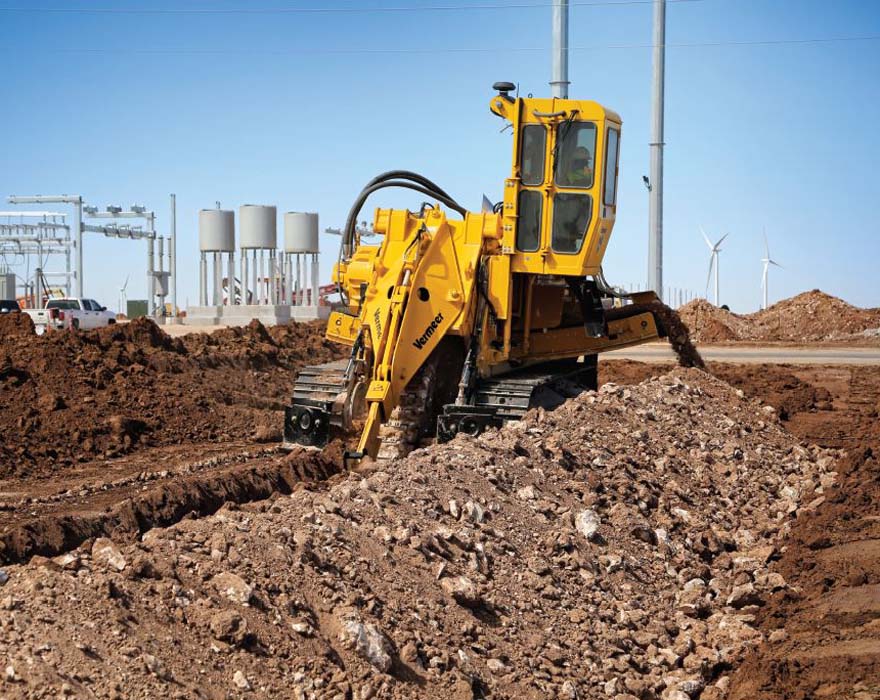The horizontal directional drilling (HDD) industry has come a long way since Vermeer introduced its first rig in 1991. The equipment, technology and drill crews have all become more sophisticated, which has helped expand the range of jobs drills can be used for. However, there is still a significant and growing market for open-cut methods, like trenching and plowing.
According to Tod Michael, product manager for the trenchless core products at Vermeer Corporation, most underground construction projects have several factors that need to be considered when choosing between trenchless and open-cut installation methods. “There are the basic economics involved in the decision, like equipment, labor and restoration costs, but there are often more that contractors need to consider that impacts the decision,” he said, “such as ground conditions, the diameter of the product, grade requirements, underground and above-ground obstacles, as well as location.”
Urban installation considerations
In countries with more developed infrastructure, HDD is usually the preferred installation method for small-diameter utilities in urban and suburban locations. Michael said minimizing restoration, avoiding traffic disruptions and keeping property owners happy are a few of the reasons why HDD is used in populated areas. “Most of the time, boring a utility line is more cost-effective and takes less time because you go under roads and sidewalks, not through. Also, you do not have to contend with above-ground obstacles, like fences, roadways, sidewalks and driveways,” he added.
There are regions of the world that still prefer to use open-cut methods in urban and suburban environments. Björn Van de Weghe, applications specialist for Vermeer EMEA (Europe, Middle East and Africa), explained unmarked underground utilities are a major concern in some cities. Van de Weghe said, “Trenchless methods are still used for crossing under roads and bridges, as well as over longer distances where no connections have to be made or crossed.”
Rural installation considerations
In rural areas, since there is often less restoration and obstacles to contend with, trenching and/or plowing is typically faster and more cost-effective for smaller diameter product.
According to Jeff Utter, product manager at Vermeer Corporation, in more wide-open areas, contractors still need to consider which method makes the most economic sense. “Accounting for existing utilities, type of soil, the size of the product being installed and the required depth still need to be considered before choosing,” he explained. “It may be less expensive to use an open-cut method for shallow installations. However, for deeper installations or in rocky soil conditions, HDD may still be the best choice because less material has to be removed during the installation process.”
Utter added that even if open-cut methods make the most sense for projects in rural areas, contractors should still consider using trenchless technology for passing under roadways, rivers and other above-ground obstacles.
Large-diameter pipe considerations
For pipeline projects including gas, oil or water, a combination of excavating and trenchless methods is typically used. “Over longer distances, open excavation will typically be more cost-effective than other installation methods, but the contractor should use a horizontal directional drill, auger boring machine or piercing tools to cross under roads, railways and rivers,” Michael said. “HDD should be considered for boring long distances and/or through cobble or rock. Auger boring machines are a great option for installing large-diameter steel casings short distances or if there is a limited space that would reduce the contractor’s setback distance. Piercing tools are very efficient for boring short distances and do not require a lot of setup time.”
Vermeer Corporation and its subsidiary, McLaughlin Group, Inc. manufactures a wide range of trenchless and open-cut underground installation equipment, and the dealer network can provide expert advice to help contractors determine the most appropriate method for a particular project.
For questions about trenchless and open-cut underground installation methods, contact your local Vermeer dealer or visit Vermeer.com.
Vermeer is a trademark of Vermeer Manufacturing Company in the U.S. and/or other countries.
©2018 Vermeer Corporation. All Rights Reserved.
